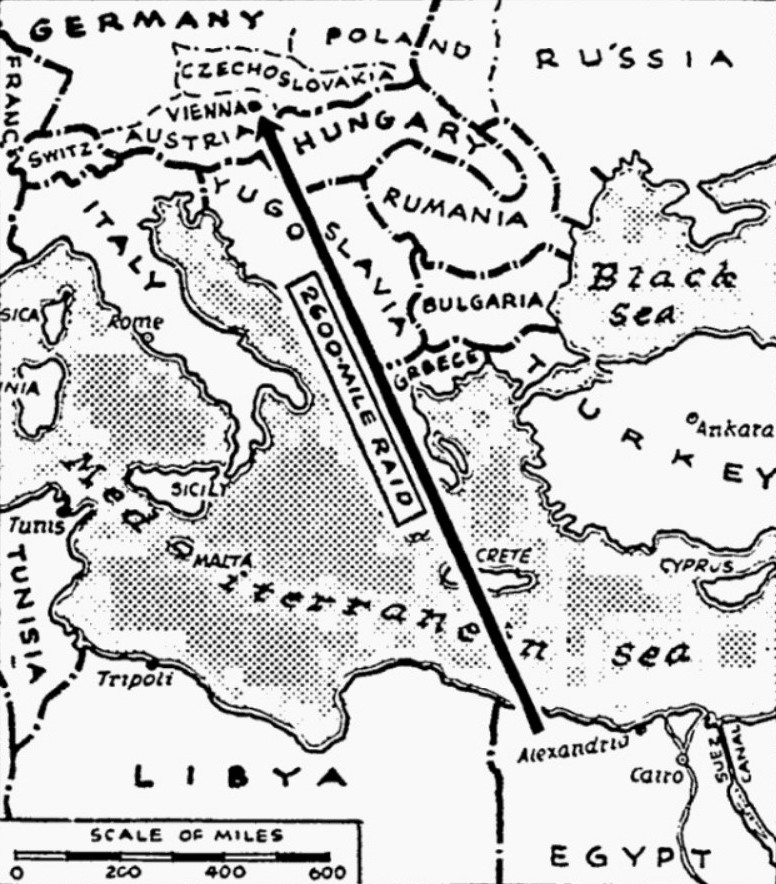The Pittsburgh Press (August 14, 1943)
Austria bombed by Yanks
Vienna airplane factory blasted in 2,600-mile raid
By Joseph W. Grigg, United Press staff writer
Liberators over Austria, in a 2,600-mile roundtrip raid from Middle East bases, bombed a German plane plant south of Vienna.
London, England –
A large force of U.S. Liberator bombers from the Middle East Command smashed at one of Germany’s biggest aircraft plants south of Vienna in a record 2,600-mile daylight raid yesterday, a communiqué revealed today.
Demonstrating to a bomb-jittery Germany that virtually no corner of its domain is now beyond the range of Allied aircraft, the giant four-engined planes dropped tons of explosive and firebombs on the Wiener Neustadt Messerschmitt works. The raid was within hours of bombing attacks in the Axis capitals – Berlin and Rome.
U.S. pilots dropped more than 350,000 pounds of explosives on the aircraft plant at Wiener Neustadt and on their return to their bases said they left it “a shambles.”
A communiqué broadcast by the Berlin radio acknowledged that the attack caused damage to buildings in “southeastern Germany” and casualties in “one place.”
The raid, the first by planes of the Western Allies on Austria, coincided with the daylight attack by Northwest Africa-based U.S. Flying Fortresses and medium bombers on Rome.
The Liberators were drawn from the U.S. 9th Air Force with headquarters in Cairo, the same force which sent a formation sweeping across Southern Europe to blast the Ploești oil fields in Romania two weeks ago. The Vienna flight was 150 miles longer than that to Ploești.
Crossing the Mediterranean and the heart of the Balkans, U.S. pilots were believed to have dealt a shattering blow to Germany’s already-faltering aircraft industry.
The Wiener Neustadt works, situated about 30 miles south of Vienna, employs several thousand workers in four or five big assembly plants which, when a member of the former United Press staff in Berlin visited them about two years ago, were turning out about 30 planes a week.
Wiener Neustadt also has one of the largest advanced air-training schools in Germany. Both plant and schools are situated on flat, open country easily identifiable from the air. The Germans had always considered the area “safe” because it was beyond the range of British-based aircraft.
The plant was opened in 1940 as one of the first steps in Adolf Hitler’s program of industrial dispersal.
The Cairo communiqué said all planes participating in the raid had been “accounted for,” an indication that casualties were comparatively small. A Zürich dispatch reported that a Liberator crash-landed in northeastern Switzerland yesterday. Apparently, it took part in the Austrian raid.
One intercepting Me 109 was shot down, the communiqué said.
The Swiss radio said that British planes flew over Sofia, dropping leaflets on the Bulgarian capital.
Hungarian radio broadcasts told of great waves of Allied planes crossing Hungary in a northwestern direction yesterday and the raid obviously lent weight to recent Allied warnings to Hungarian workers to leave factories since they soon might feel the impact of Anglo-American bombs.
It also emphasized the futility of German efforts to move their war industries and government departments out of the range of Allied bombers. Reports had reached London that the German Foreign Ministry had already been evacuated to Vienna and thousands of refugees from the bomb-pocked Ruhr and Rhineland had also been sent to the Austrian city.
Though no British or American planes ever raided Austria previously, Russian bombers have attacked Vienna on several occasions.
The Germans were so confident that Allied bombers would never attack the Wiener Neustadt factories that they did not bother even to camouflage them. Two years ago, there were no anti-aircraft guns in the vicinity. Vienna and neighboring cities have only dim-outs, not blackouts.
All individual parts used in the latest-type Messerschmitt fighters and bombers were manufactured in the sprawling plants. The planes were then assembled on moving belts in American massed-production style.
Once completed, the planes were moved out onto the plant’s own airfield for testing.
In one large building, aluminum was poured to make special light airplane alloy material.
More than half the workers in the factory were known to be women.
British Wellington bombers from the Middle East scored a torpedo hit on an enemy merchant vessel in the Aegean Thursday night, the Cairo communiqué said. When last seen, the vessel was settling by the stern.
